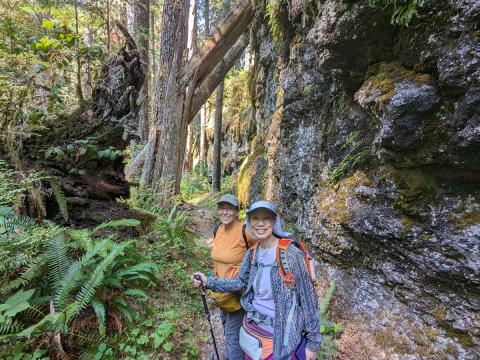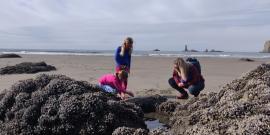
Binoculars - don't leave home without them!
We bring one pair of binoculars to share
We additionally bring a spotting scope to enhance wildlife viewing except on long and strenuous hikes
If you do not already own binoculars, please consider purchasing 8 x 42, waterproof, excellent close-focus capability (5 feet), and purchase a separate shoulder harness for enhanced comfort while hiking (lack of neck strain).
Personal use of high-power binoculars can be a transformative wildlife viewing experience and an exciting addition to your Experience Olympic tour.
Bring good shoes, wool-blend socks, and sunglasses
Wear hiking boots or the most supportive shoes you own: close-toed shoes only please
We will bring one pair of trekking poles to share. Ideally bring your own trekking poles, though you will have to check the poles with your baggage if traveling by air
If you end up loving trekking poles like I do, you could purchase trekking poles here in Port Angeles at Browns Outdoor and then send them back to your house by post
Bring sunglasses, sun hat, warm hat, and sunscreen
Do not wear cotton clothing if there is a chance of rain or snow, generally we have warm sunny weather in July and August

Long hikes and tidepooling tours
Do not wear cotton clothing (especially jeans)
Wear hiking boots with full ankle support
Bring extra wool-blend (non-cotton) socks.
Wear wool or synthetic (nylon) pants
Be prepared to carry a minimum of a liter of water.
Parents of young children: Please bring age-appropriate outdoor gear for your young nature lovers. Always have a warm hat, sun hat, and extra warm layer for them. It gets especially cold by the water in August (also called Fogust)
Best practices when touring with us
Bring your medication(s), even if you think you don't need them.
Drink plenty of water and snack often, even on cool, wet days.
Take many short rest breaks, not long breaks where your muscles begin to stiffen up.
Moderate your temperature by using appropriate layers of clothing.
Watch out for other tour participants getting fatigued and take appropriate action and care.
Dress in layers - tshirt, long sleeve shirt, puffy, and rain jacket
Olympic National Park weather can change rapidly and many people are caught unprepared.
We encourage you to learn to dress in layers. We wear lined pants or long underwear under light weight pants in the late fall, winter, and early spring. We bring rain pants to put on as an extra layer.
I always bring a ball cap, wide brim sun hat, warm hat, and light wool or synthetic gloves
Make clothing choices to avoid fall foraging wasp attention
Certain clothing and scented choices can help to minimize the likelihood of contact with wasps, especially during the fall.
Please don't use toxic repellents unless you are backpacking and camping next to a high lake in the summer.
Bring close-fitting white or tan clothing and avoid loose-fitting bright-colors especially light blue, pink, red, or orange.
Minimize use of scented body products like perfumes.
Enjoying the outdoors safely
Experience Olympic maintains a registered Personal Locator Beacon (PLB) allowing for 911 satellite communication.
We are therefore not dependent on cell phone coverage, which can be inconsistent on the Olympic Peninsula.
Your hiking guide carries the PLB in their backpack along with an additional first aid kit and has Wilderness First Responder training.
If you spend a lot of time outdoors, consider Wilderness First Aid training. It's a great short course and covers so much more material than standard First Aid.
